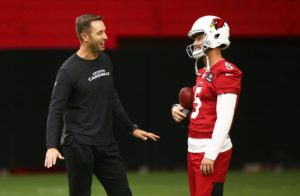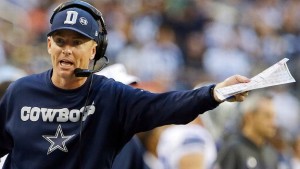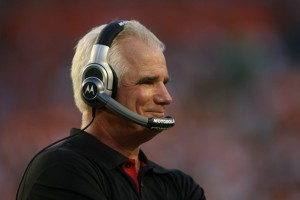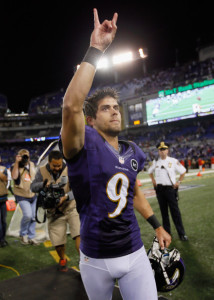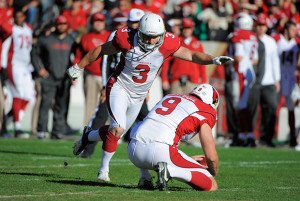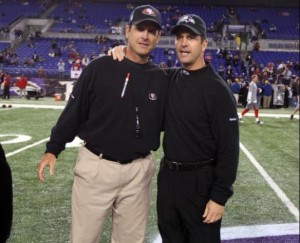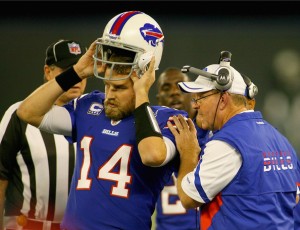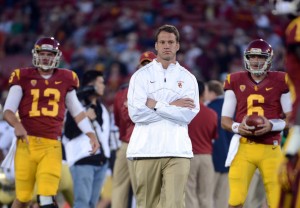[Note: I’m scheduled to appear on The Bobby Curran Show on ESPN 1420 at just after 12:30 today. If you’re interested, you can listen here.]

Mike Tomlin can't see why going for it on 4th down is so unconventional.
If you weren’t watching the Steelers-Raiders game, you probably didn’t hear about
Mike Tomlin’s gutsy call late in the 4th quarter. That’s because it worked.
On 3rd-and-1 with 4:34 remaining in a tie game, Pittsburgh had the ball at their own 29-yard line. The Steelers ran Isaac Redman over the left guard for no gain, leaving them in a precarious position. According to Brian Burke, immediately following Redman’s run, Pittsburgh had just a 34% chance of winning the game. This makes sense, because on average, punts from the 29-yard line end up with the other team gaining possession at their own 33-yard line (net of 38 yards). This conforms with Burke’s win probability model, which states that a team with 1st and 10 at their own 33 with 3:45 remaining has a 66% chance of winning.
That’s just the average, though. What about the specific teams in this case? Pittsburgh has a rookie punter, so we probably shouldn’t assume anything better would happen if they punted. The biggest variable in the Raiders’ favor was the presence of Sebastian Janikowski, an uber kicker who appears capable of connecting from anywhere on the opponent’s side of the field. Since 2010, Janikowski is 12-of-18 from 50-yards or more, including a miss from 65; on average, those 18 kicks were 55-yard attempts. Essentially, if the Raiders got 30 yards after the punt, they would have had a very good chance of winning the game.
Of course, the Steelers defense is generally one of the best in the league, even without Troy Polamalu and James Harrison. The Raiders had scored 3 touchdowns and a field goal on their prior 4 drives, although we shouldn’t let a small sample size persuade us too much. Additionaly, the Steelers would go three-and-out after converting the 4th down, and the Raiders ended up driving down the field and kicking the game-winning field goal, anyway. Again, it’s tempting to consider this when determining the Raiders’ odds of winning following a punt, but that’s the sort of logic I would rally against if the circumstances were different.
My gut tells me the Raiders being at home, having a pretty decent offense, and a super kicker would outweight the fact that generally Pittsburgh has a very good defense. So at a minimum, I’d argue that a Steelers punt gives the Raiders a 66% chance of winning.
If Pittsburgh converted, they’d probably have the ball somewhere between their own 30 and 35-yard lines; ironically, right where the Raiders ended up having the ball. That makes the calculus pretty easy: Pittsburgh would have a 66% chance of winning if they converted. You might argue that their odds would be greater, because of the presence of Ben Roethlisberger and a strong passing attack and considering Oakland’s pass defense is suspect. I’m sure Steelers fans were very confident that they would win the game after converting on 4th-and-1, but taking the conservative approach would say Pittsburgh had “only” a 66-percent chance of winning if they converted.
Now what were the odds of converting? As always, you can trade a larger sample for a more precise one, and determining the appropriate cutoff is tricky. I looked at all plays in the second half or overtime of games where the team had 4th-and-1 on their own side of the field. I also limited this to games where the team was trailing by 3 or fewer, tied, or winning, to make sure that defenses were truly focused. That left 64 examples from ’00 to ’11.
Teams converted 48 of the 64 attempts, or exactly 75% of the time. On average the teams gained 2.8 yards with a median gain of 2 yards. 55 of the 64 times the team ran the ball, with 44 of those being successful (80%). Only 4 of the 9 passes were successful, although the quarterbacks in the misses (Ryan Leaf, Byron Leftwich, Jason Campbell, Gus Frerotte and Alex Smith) leave something to be desired.
If we increase the sample to any 4th-and-1 attempt outside of the opponent’s 30 (so the first 70 yards of the field for the offense), teams converted 67% of the time. Let’s split the difference and give Pittsburgh a 70% chance of converting.
Facing 4th-and-1, Pittsburgh has a 70% chance of getting a 66% chance of winning the game; that means they have a 46% chance of converting the 4th-and-1 and of then winning the game. This ignores the possibility of Pittsburgh missing the 4th-and-1 and still winning the game, which is clearly non-zero. And remember, if they punt, they have only a 34% chance of winning. Even if we force them to automatically lose if they don’t convert, they still are more likely to win the game by going for it. In fact, they only need to convert half of the time on 4th-and-1 to make it a break-even proposition, and that’s still ignoring the possibility of failing and still winning.
What are the odds of that? With just under 4 minutes left, maybe not as bad as you think. If Oakland has the ball at the Steelers’ 29-yard line, they are extremely unlikely to be able to run out the clock. Pittsburgh called its first timeout before the 4th-down decision, meaning the Steelers still would have had 2 timeouts left if they could not gain one yard. Odds are the Raiders play it pretty conservatively and kick a field goal, and the Steelers have 2 minutes to go to kick a field goal to force overtime (or score a touchdown). That’s hardly a hopeless position in which to be.
Based on past history, Oakland would have had an 82% chance — not 100% — of winning if they had the ball at the Pittsburgh 29-yard line with 3:45 left in the game. Oakland’s odds would be higher because of Janikowski, although that would be counterbalanced by Pittsburgh having one of the best quarterbacks in the league in the two minute drill.
Add it all up, and it becomes a pretty obvious call… unless you’re risk averse. If Pittsburgh punts, they have just a 34% chance of winning, maybe even lower because of Janikowski. If Pittsburgh is successful, they are the team with the 66% chance of winning; if they miss, they still have an 18% chance of winning, based on having a small chance of winning in regulation and a decent chance of still going to overtime based on the amount of time remaining. Note that if there was one minute left, Pittsburgh’s odds of winning drop to just 9% if they don’t convert, but with nearly 4 minutes to go, they would not be out of the game if they failed. Considering a 70% success rate on 4th and 1, and they would have a 52% chance (66% x 70% + 18% x 30%) of winning they game if they went for it. In other words, punting it on 4th and 1 would drop Pittsburgh’s odds of winning from 52% to 34%, making this a significant and obvious decision for Tomlin.
To make punting the better decision, you would really need to skew the odds. If you have the utmost faith in your defense, perhaps you think the Raiders having the ball at their own 33-yard line with 3:45 to go doesn’t make them the favorite to win. If you view that as a coin-flip game — a pretty difficult proposition to believe — Pittsburgh would *still* benefit by going for it, since their win probability was 52%.
It also would have been wise to go for it if they were winning by 1 or 2 points… or even 3 points. A larger lead and it gets a little cloudy, but this is not much different than Bill Belichick’s decision against the Colts a few years ago. At the end of the game, especially in today’s high-octane NFL, you don’t want to be in a close game without the ball.
And as you can see, converting the 4th down was one of the biggest swings in the game. Take a look at Brian Burke’s win probability graph:
I said it was an obvious call unless you’re risk averse. As we all know, NFL coaches think conservatives are very liberal. On the surface this wasn’t a unique situation, but when you try to find comparables, you have to limit yourself. Since 2000, I looked at all situations where a team faced 4th-and-1 on their own side of the field, in a game where they were leading by 8 or less (or were tied), and with between 2 and 6 minutes remaining. There were only 20 situations like that, and 18 times the teams punted. The two other times? One came in week 17 for the Steelers in the game where Jamal Lewis crossed the 2000-yard mark and Pittsburgh was trying to close the curtain on a 6-10 season. A year after “4th and 2“, Bill Belichick went at it again against the Chargers. With exactly 2 minutes to go and the ball at the Patriots 49, New England ran it on 4th and 1. They missed, but went to win after Kris Brown could not connect on a 50-yard field goal.

